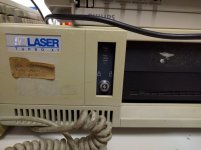Bought a xtide card and have spent some time trying to get it to function in a laser turbo xt. The Xtide is cabled to a startech cf adapter holding a 256 mb sandisk cf. What I have done is...
Formatted the cf (tried both FAT and FAT 32.)
This led to a disk that could be seen by the xtide bios but couldn't be accessed.
So i tried the hard drive format utility that came with the machine.
I could the go into drive c but every time I attempted to make a directory or copy a file I just got a file error. When I brought the card back to my xp machine it now read as RAW and showed 33MB so obviously the Mfm format utility wasn't a good idea.
So anyone know a working process to get this going?
Thanks
Formatted the cf (tried both FAT and FAT 32.)
This led to a disk that could be seen by the xtide bios but couldn't be accessed.
So i tried the hard drive format utility that came with the machine.
I could the go into drive c but every time I attempted to make a directory or copy a file I just got a file error. When I brought the card back to my xp machine it now read as RAW and showed 33MB so obviously the Mfm format utility wasn't a good idea.
So anyone know a working process to get this going?
Thanks

